Shep Hyken's Blog, page 78
September 10, 2021
Guest Post: Customer Experience: Expectation vs. Reality
This week we feature an article by Tanya Ahmed, a Digital Marketer of Vantage Circle, a cloud-based employee engagement platform. She writes about what customers expect from companies in 2021 and what they actually get.
Consumers today expect speedier access to services than ever before. They count on meaningful interactions with service professionals who make them feel valued. Customers want their concerns resolved swiftly, without having to wait in line or being handed from one executive to another.
A good customer experience (CX) begins with a 24-hours seamless website user experience, followed by top-notch customer care, and concludes with the receiving of the product/service purchased from you.
Companies failing to meet good customer experience lose out on their customers (American Express Survey 2011). Estimations show that about 78% of consumers on a transaction did not choose to make an intended sale.
In this post, we shall compare five customer expectations in 2021 to their reality. It will enable you in identifying the reasons behind high customer turnover and what you can do to address them.
Expectation: Customers expect connected journeys with consistent interactions.Reality: Customer Service generally feels like sales.
One big mistake we see in customer service is the assumed customer journey. An expected customer journey reflects the commercial perspective on what works and what does not. But it doesn’t capture the customers’ views, customer touch-points, or emotional drivers.
Assumptions can lead to unhappy customers, leaving them feeling disconnected. Here are five ways to turn disconnected customers into loyal customers:
Respond to customer concerns promptly. Follow up with customers after-sales. It helps communicate to them that they matter. It also helps you identify poor customer experiences. Speak to your customers in a conversational and personal tone. Try to avoid being transactional. Prioritize your existing customers over the acquisition of potential customers. Use customer surveys to improve customer insight and offerings. Expectation: Customers expect personalization and want companies to understand their unique needs.Reality: Customers are generally treated like numbers.
Personalized customer service is about treating people as individuals. Personalized customer experiences drive up customer loyalty. It also enables businesses to differentiate themselves and gain a sustainable competitive advantage.
The following five-step plan will help you build a personalized customer experience:
Create a customer-focused vision statement. Provide an omnichannel service experience. Develop a self-service experience. It should include FAQs, explainer videos, and step-by-step solutions for common problems. Provide employee feedback platforms that can help stimulate small changes. These changes can make a massive difference in customer experience. Use customer feedback and craft an action plan that addresses what your customers want from you. Expectation: Customers expect innovation.Reality: Digital initiatives abruptly accelerated after the Covid-19 pandemic making businesses unsure how to offer their products and services to maximize profit.
Customers expect constant innovation. We are in an era where a company’s innovative experiences are as important as the quality of its products. New 2019 research found that 84% of customers consider these factors equally when deciding whom to buy from.
Innovation is accelerating across industries with emerging technologies like artificial intelligence (AI) and the Internet of Things (IoT). In my experience, many companies lose their way when looking to enhance their brands through innovation.
Here are three ideas to keep innovation on track:
Innovation should be customer-centric. Marketing teams should be experimenting with new tactics and not merely offering discounts every month. Educate your customers about the new technologies so that they can easily extract value from the innovations. Expectation: Customers expect data protection.Reality: Customers feel they no longer have control over how their personal information is used.
Privacy concerns are a result of consumers’ awareness of how companies are using their data. About 65% of consumers are concerned about how personal data is collected, according to the Internet Society and Consumers International.
These concerns highlight the importance of being open and honest with your customers. This is not simply a regulation to follow, but it is also an ethical thing to do. The more transparent you are with your consumers, the more trust they will have in you.
Follow the four steps to keep your customer data more secure-
Only collect vital data Limit access to data Use password management tools Avoid data silos Expectation: Customer service equals the staged portrayals in the commercials.Reality: There is seldom a gap between what is digital advertising and offline sales.
Companies build high customer expectations through innovative advertising and word-of-mouth. But when over-promising in advertising does not match the actual deliverables, it creates customer service gaps.
Recognizing and closing service gaps is vital as it offers high-quality customer service and customer satisfaction. It also helps product managers to maximize the company’s market position and financial results.
Here are four smart ways to help you deliver a positive experience:
Know where your customers engage with your business online. Use smart tools to understand the customer journey better. Capture interest by personalizing and contextualizing digital ads. Use cross-channel marketing to deliver connected brand experiences.Tanya Ahmed is a Digital Marketer of Vantage Circle, a cloud-based employee engagement platform. Her experiences range from various fields, including Customer relationships, Content Creating, Sales & Marketing.
 For more articles from Shep Hyken and his guest contributors go to customerserviceblog.com.
For more articles from Shep Hyken and his guest contributors go to customerserviceblog.com.
Read Shep’s latest Forbes article: A Little Laughter Decreases Stress And Improves Productivity
The post Guest Post: Customer Experience: Expectation vs. Reality appeared first on Shep Hyken.
September 8, 2021
You’re Terminated: Three Reasons Customers Will Stop Doing Business with You
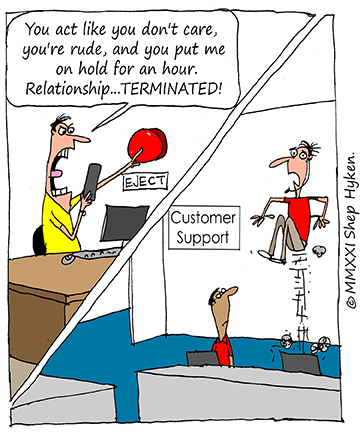 One of the favorite chapters I wrote in my recent book, I’ll Be Back: How to Get Customers to Come Back Again and Again, was about why customers would terminate their relationship with you. Yes, the word terminate ties into the movie Terminator, which somehow became a theme in the background of the book. So, why would a customer terminate his or her relationship with you?
One of the favorite chapters I wrote in my recent book, I’ll Be Back: How to Get Customers to Come Back Again and Again, was about why customers would terminate their relationship with you. Yes, the word terminate ties into the movie Terminator, which somehow became a theme in the background of the book. So, why would a customer terminate his or her relationship with you?
In the book, I shared 10 reasons, although there are many more. These reasons are derived from our customer service and experience research, which revealed what was most important to the customer. So, it makes sense that the opposite would be the reasons that customers might terminate their relationship with you and your organization. With that in mind, here are three reasons a customer would choose to say, “Hasta la vista, baby!” (Okay, I couldn’t resist another Terminator reference.)
Apathy – Want to irritate a customer? Just act like you don’t care. Apathy can come across as if you don’t care about the customer. It can even look like you don’t care about your company. You’re just going through the motions. Your investment in the job has nothing to do with the company or taking care of customers. You’re simply working for take-home pay, and it shows. Rudeness – I’m not sure which is worse, rudeness or apathy. At least with rudeness, there can still be some sort of emotion displayed. An employee can be good at the technical side of the job – and care about the company – but be terrible when it comes to dealing with the customer. I’ve encountered front-line employees in customer support and sales positions who should never have been put on the front line. As knowledgeable as they might be, they are rude and have a communication style that often comes off as disrespectful. Inability to Connect – Customers hate friction, and one of the friction points we found in our research is when customers have difficulty getting the contact information they need to call customer support. And sometimes, even when they have the information, they find it difficult to find the right person to talk to. A couple of suggestions here. First, make it super easy for customers to reach out to you, and I’ll add, the way they want to reach out to you. Make your phone number and email address easy to find, and be available on other channels you know your customers like to use (text, social media, etc.). Second, if the customer reaches the wrong person on the first attempt, be sure that the employee knows who the right person is. In other words, the employee may not be trained to answer every question a customer will ask, but they know who to transfer the customer to when they don’t.Well, there you have it. Three reasons that customers might terminate their relationship with you. I believe these, and other reasons in the book, fall into the category of common sense. Yet, it surprises me how many companies and employees fail to deliver on these basic ideas.
Shep Hyken is a customer service expert, keynote speaker, and New York Times, bestselling business author. For information on The Customer Focus customer service training programs, go to www.thecustomerfocus.com. Follow on Twitter: @Hyken
customer service training programs, go to www.thecustomerfocus.com. Follow on Twitter: @Hyken
(Copyright © MMXXI, Shep Hyken)
The post You’re Terminated: Three Reasons Customers Will Stop Doing Business with You appeared first on Shep Hyken.
September 7, 2021
Amazing Business Radio: Rick DeLisi and Dan Michaeli
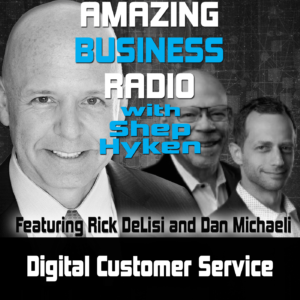 Digital Customer Service
Digital Customer ServiceTransforming Customer Experience for an On-Screen World
Shep Hyken interviews Rick DeLisi and Dan Michaeli, authors of Digital Customer Service: Transforming Customer Experience for An On-Screen World. They discuss why customer-centric companies need digital transformation.







Top Takeaways:
Digital Customer Service is about interactions that take place on-screen or have a component of on-screen enhancements (on-screen automation, on-collaboration, on-screen communication).Virtually every service experience starts as self-service. When a customer goes into a company’s website or mobile app, they are at the beginning of their digital self-service journey.In a digital customer service interaction, the customers are already logged in and have already begun their search for answers. If and when a human-to-human interaction is needed, the customer support agent should be able to know who the customer is and what they are looking for.US companies alone still receive more than one billion incoming phone calls every year. Many companies claim to be customer-centric yet still expect customers to call them when they need help even in today’s on-screen world.Whether you are a B2B or a B2C business, your customers have learned what the best digital experience looks like from the most successful companies.Quotes:“Customers are now “on-screen” and companies need to meet them on the channels that they are using to enhance the effectiveness, efficiency, and experience of every interaction.”
“The focus of Digital Customer Service is finding the right balance between human interaction and virtual interaction (such as automation and AI) depending on what the customer needs.”
“The biggest myth about Digital Customer Service is that it doesn’t involve human interaction and that everything is handled by AI or bots.”
“The impact of the pandemic is that it made all of us digital natives. We are all always within an arm’s reach away from a screen 24 hours a day.
“Customer effort, one of the biggest predictors of loyalty after a service interaction, is formed by one-third of what the customer needs to do and two-thirds of how it feels to them.”
About:Rick DeLisi is the co-author of the best-selling book, The Effortless Experience. He has been researching the psychology of customer behavior and expectations in service for the past two decades
Dan Michaeli is the CEO of New York-based Glia, a leader in helping companies reinvent how they serve their customers. He develops solutions that create world-class digital customer experiences for “traditional” non-digital-native organizations.
Shep Hyken is a customer service and experience expert, New York Times bestselling author, award-winning keynote speaker, and your host of Amazing Business Radio.
This episode of Amazing Business Radio with Shep Hyken answers the following questions … and more:
What is Digital Customer Service?Why should companies undergo a digital transformation?What is the difference between customer service and self-service?How can companies find the balance between human interaction and digital interaction?What is a digital native?The post Amazing Business Radio: Rick DeLisi and Dan Michaeli appeared first on Shep Hyken.
September 6, 2021
5 Top Customer Service Articles of the Week 9-6-2021
Each week I read many customer service and customer experience articles from various resources. Here are my top five picks from last week. I have added my comment about each article and would like to hear what you think too.
When Customer Care Isn’t Enough, Call the Customer Delight Brigade by Katie Deighton(Wall Street Journal) Staff members at the George Eliot Hospital in the English town of Nuneaton are used to the sight of flowers being delivered to patients. They are not so used to receiving flowers themselves, and certainly not used to the arrival of 100 bouquets, like the ones that arrived last week without warning.
My Comment: This excellent Wall Street Journal article starts with a story about a company doing something special to “delight” their customers. Quoting: “We give every member of our customer delight team a budget to look for opportunities to proactively go out of the way to do something nice,” said Aron Gelbard, Bloom & Wild’s co-founder and chief executive officer. The idea behind the article is to “delight” the customer, rather than to just serve them.
A Customer Discovered Their $350 Lego Set was Missing Pieces. The Company’s Response Was Brilliant by Jason Aten(Inc. Magazine) Delight is maybe the most powerful thing you can do to generate loyalty among your customers. It doesn’t take much, but even little things like knowing your audience and responding accordingly can go a long way.
My Comment: Next on this week’s Top Five is a fun article that starts with a great story. This is the kind of thing that creates CX legends. After the author shares the story, he offers commentary about why what this brand did (Lego) was so successful. You’ll smile.
Customer Service is SO Annoying (Tips to Make it Less So) by Jim Gilbert(Total Retail) We help customers deal with bug infestations: bed bugs, mites, fleas, lice, and they’re desperate, getting bitten up, not sleeping and generally miserable. And they want to tell you every detail of their lives and how the bugs are affecting them.
My Comment: Don’t be confused by the title of the article. As the author points out, this is really an article about great customer service, and he shares a number of solid tips on how to do so. I also smiled at his story about the customer who calls him so much, she refers to him as her boyfriend.
A Look at Customer Effort Score and How It Can Help Build Better CX by Dom Nicastro(CMSWire) Customer Effort Score (CES) is a metric used to determine the amount of effort it takes customers to accomplish a specific task within a brand experience. It is one of several customer experience (CX) metrics that place hard values on a brand’s CX and often works in conjunction with metrics like Net Promoter Score (NPS), Customer Churn Rate (CCR) and Customer Satisfaction Score (CSAT).
My Comment: One of the metrics I like in business is the Customer Effort Score, which measures the ease in doing business with a company, usually tied to their customer support. This excellent article shares the formula and has an easy-to-understand description of how to use the information to create a better customer experience.
CX Best Practices: Learning from AWS Contact Center Day by Sébastien Stormacq(No Jitter) It’s taken years of trial and error to get Amazon customer experience to where it stands today — and now you can learn from our progress.
My Comment: About two months ago I had the great opportunity to work with Amazon AWS as one of their speakers at their Contact Center Best Practices Event. This short article has a summary of three important best practices that you should consider for your business.
BONUSState of the In-Store Experience [2021] by Bobby Marhamat(Raydiant) As consumers have grown accustomed to online experiences, they’ve come to expect a similarly digital in-store experience. Physical brick-and-mortar locations—retail stores, gyms, restaurants, or otherwise—must now be digital, automated, and personalized to the customer.
My Comment: This is a great report about trends related to the “in-store” customer experience. Even if you’re not in the retail world, you’ll enjoy these stats. You’ll get some insights into customers preference of physical shopping experience versus online. The last section includes some commentary from me and other customer service and experience experts. It’s gated, so you’ll have to include your email address, but it’s worth it. And, they won’t spam you.
Shep Hyken[image error] is a customer service expert, professional speaker, and New York Times bestselling business author. Go to The Customer Focus to learn more about our customer service training programs. Follow on Twitter: @Hyken
to learn more about our customer service training programs. Follow on Twitter: @Hyken
The post 5 Top Customer Service Articles of the Week 9-6-2021 appeared first on Shep Hyken.
September 3, 2021
Guest Post: Maximize Productivity with a Customer Experience Management Platform
This week we feature an article by Apira Giriharan, a Marketing Manager from Blackchair with extensive knowledge of all matters related to CX solutions. She writes about how contact center agents can maximize productivity and provide a better customer experience.
Contact center agents are often hampered by a lack of data and resources, which undermines their productivity.
Research shows that 86% of agents feel they don’t have the resources or the authority to deal with customers effectively, which hurts productivity and service quality. For example, around 20-30% of call volume in any contact center has unresolved issues, and over 60% of First Caller Resolution (FCR) attempts fail due to an agent’s inability to access the right data.
A customer experience management platform (CX management platform) can improve the quality of customer service by empowering CX agents with the data and the tools they need to provide high-quality customer service, raising agent productivity and the overall quality of service.
What is a CX management platform?CX management software is an AI-driven, cloud-based platform that optimizes technical operations related to customer service.
Contact centers work with several CX vendors to meet business and technical requirements, creating a complex ecosystem where different CX platforms complete different functions.
However, this creates an ecosystem where different CX vendors are separate from each other, making it difficult for CX agents to get the information they need to provide quality customer service efficiently.
A CX management platform acts as a vendor-agnostic interface that can remove the silo between CX vendors; this creates a more transparent and efficient CX ecosystem that in turn generates several business and technical benefits to improve agent productivity.
How can a customer experience management platform improve productivity?Let’s take a look at how a CX management platform can improve CX agent productivity and reduce operating costs.
Eases access to customer informationTo do their jobs properly, CX agents need quick access to customer information when a customer calls.
Customer experience management platforms enable quick, easy access to customer data by breaking down the silo between CX platforms and creating a transparent environment.
Automates repetitive CX operationsMost CX management systems can automate repetitive tasks, reducing the workload of most CX agents.
CX agents have to complete several monotonous tasks that are time-consuming and not the best use of their skillset. However, by investing in a management platform, these tasks can be completed without agent supervision.
This frees up their time for more value-oriented, productive tasks, which saves time, reduces costs, and improves productivity.
Minimizes interference during CX migrationThere are times when contact centers need to be migrated to a different platform. However, if the migration process is not planned properly, it can disrupt CX agent productivity because the system is not as stable as it should be.
A CX management system reduces disruptions during migration.
Furthermore, the platform can minimize the disruption to work by optimizing workforce scheduling, allowing you to plan your agents’ workload around the migration process, so your agents can remain productive even as you move to a new vendor.
Reduces time taken to complete certain CX operationsCX management platforms can reduce the time taken to complete certain technical operations, like system auditing and troubleshooting.
When the CX platform is down, CX engineers need to troubleshoot the cause and devise a solution to get the platform back up online. This process can take a lot of time, during which the system would be down, hurting productivity.
However, you can automate the process using a CX management platform; engineers can use the technology to speed up the auditing and troubleshooting process, reducing system downtime and making it easier to diagnose errors and resolve them.
This leads to several benefits including a more transparent CX environment that would allow engineers to operate more efficiently.
Improving contact center agent performance with a CX platformAs the standards for customer service grow, it is important to invest in systems that would empower your CX agents with the necessary tools that would turn them into productive powerhouses.
A customer experience management platform provides the ideal environment for CX agents to remain efficient and productive. This would allow your organization to provide high-quality customer service in the form of higher FCR rates, lower average wait times, and better service quality.
Apira Giriharan is a Marketing Manager from Blackchair with extensive knowledge of all matters related to CX solutions. Her experience and position give her a well-rounded view of the industry, granting her an insightful perspective on what can be a complex topic.
 For more articles from Shep Hyken and his guest contributors go to customerserviceblog.com.
For more articles from Shep Hyken and his guest contributors go to customerserviceblog.com.
Read Shep’s latest Forbes article: Customers Will Pay More For This
The post Guest Post: Maximize Productivity with a Customer Experience Management Platform appeared first on Shep Hyken.
September 1, 2021
Amazon Sets the Standard for Every Business
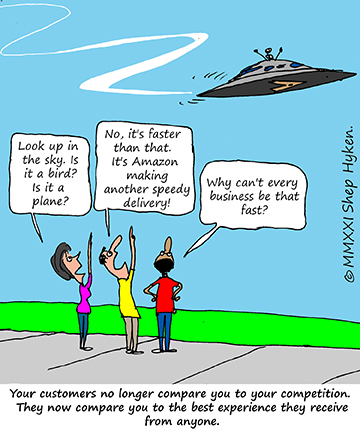 I’ve written about this before. Our customers are smarter than ever when it comes to customer service and receiving a great customer experience. They no longer compare us only to our direct competitors, but instead, to the best service they have received from any company, large or small, global or local. These companies are setting the bar higher. They are forcing everyone in business to up their game, and that’s great for us as customers.
I’ve written about this before. Our customers are smarter than ever when it comes to customer service and receiving a great customer experience. They no longer compare us only to our direct competitors, but instead, to the best service they have received from any company, large or small, global or local. These companies are setting the bar higher. They are forcing everyone in business to up their game, and that’s great for us as customers.
One company that has been continually setting new standards and forcing all companies to step up is Amazon. That’s nothing new. They’ve been doing it for decades. Amazon revolutionized the book industry and eventually the entire retail industry.
The reason I bring this up is that I get pushback from the B2B world. Some of my B2B clients don’t think they have to meet Amazon’s level of service. Some think it’s an unfair comparison. I disagree, and here is the story to prove it.
One of my clients, a healthcare organization, ordered a $500,000 imaging machine. The client commented on how the machinery was delivered ahead of schedule. Now, most people would be happy that something showed up ahead of schedule, but not this time. It was unexpected. The area that would house this piece of equipment wasn’t yet prepared. And this is what my client said:
“I can’t believe we weren’t notified that it was going to be delivered. Even when I order toilet paper from Amazon, they send me an email to tell me it is on its way.”
Yes, my client was comparing the delivery experience of a half-million-dollar medical X-ray machine to toilet paper.
Here is the point. You may not compete with Amazon, but Amazon is molding your customers’ perceptions about what goes into good service and a positive customer experience. It offers convenience, communication, delivery, customer support and more. The sooner you start to recognize this, the better. Unconsciously, your customers already are. Their brains are now wired to expect more.
The big question is this: Regardless of the type of business or industry you are in, have you adapted the way you do business to meet the new expectations of a customer who has been, for lack of a better word, Amazonized?
So, the next time your customer seems a bit more demanding than you think is normal, recognize that there is a new standard being set by one of the most iconic brands in the history of business. I challenge you to accept that fact and to do business accordingly.
Shep Hyken is a customer service expert, keynote speaker, and New York Times, bestselling business author. For information on The Customer Focus customer service training programs, go to www.thecustomerfocus.com. Follow on Twitter: @Hyken
customer service training programs, go to www.thecustomerfocus.com. Follow on Twitter: @Hyken
(Copyright © MMXXI, Shep Hyken)
The post Amazon Sets the Standard for Every Business appeared first on Shep Hyken.
August 31, 2021
Amazing Business Radio: Dan Gingiss
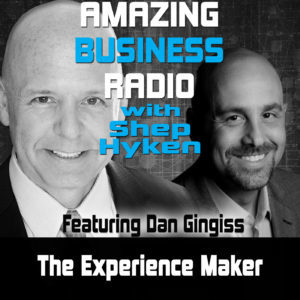 The Experience Maker
The Experience MakerCreating Consistent Exceptional Customer Experiences
Shep Hyken interviews Dan Gingiss, an international keynote speaker, coach, and author of The Experience Maker. They discuss how to create experiences that customers want to talk about.






 Top Takeaways:An Experience Maker is that person in an organization that wears the customer hat at all times. They think through every business problem from a customer’s perspective.Each person in the company should be an Experience Maker. Even those working in the back office without direct customer interaction should always have the customer in mind.All marketers want the elusive goal of word-of-mouth marketing. It’s not about the next marketing campaign or splashy video. It is creating consistent, exceptional experiences that get customers to talk about your brand.WISER is a framework that companies can use to create experiences that people want to talk about. It means:Witty – This is not necessarily about humor or being funny. Being witty as a brand is about being clever, using language to your advantage, and refusing to be boring.Immersive – Create consistent experiences that people connect with emotionally.Shareable – Give people a subtle nudge to share their customer experiences with others. The more brands tell people to share about them on social media, the less likely they are to do it.Extraordinary – Be just a little bit better than everyone else.Responsive – Be engaged with customers when they engage with you.Be a customer of your own company so you can see what your customers see. This is how you can uncover your customers’ pain points, the things that you are doing well, and the things that you should be doing more of.Quotes:
Top Takeaways:An Experience Maker is that person in an organization that wears the customer hat at all times. They think through every business problem from a customer’s perspective.Each person in the company should be an Experience Maker. Even those working in the back office without direct customer interaction should always have the customer in mind.All marketers want the elusive goal of word-of-mouth marketing. It’s not about the next marketing campaign or splashy video. It is creating consistent, exceptional experiences that get customers to talk about your brand.WISER is a framework that companies can use to create experiences that people want to talk about. It means:Witty – This is not necessarily about humor or being funny. Being witty as a brand is about being clever, using language to your advantage, and refusing to be boring.Immersive – Create consistent experiences that people connect with emotionally.Shareable – Give people a subtle nudge to share their customer experiences with others. The more brands tell people to share about them on social media, the less likely they are to do it.Extraordinary – Be just a little bit better than everyone else.Responsive – Be engaged with customers when they engage with you.Be a customer of your own company so you can see what your customers see. This is how you can uncover your customers’ pain points, the things that you are doing well, and the things that you should be doing more of.Quotes:“Every decision a company makes affects the customer. An Experience Maker makes sure that these decisions have a positive impact.”
“Being an Experience Maker is more than a title, it is a mindset.”
“Focusing on the customer will lead to more productivity. Think about the customer in every decision.”
“Focusing on remarkable customer experiences that get customers talking will result in the word-of-mouth marketing that all companies want.”
About:Dan Gingiss is an international keynote speaker and coach. His 20-year professional career included leadership positions at McDonald’s, Discover, and Humana. He is an author of two books (The Experience Maker and Winning at Social Customer Care) and the host of multiple podcasts and video series.
Shep Hyken is a customer service and experience expert, New York Times bestselling author, award-winning keynote speaker, and your host of Amazing Business Radio.
This episode of Amazing Business Radio with Shep Hyken answers the following questions … and more:
What is an Experience Maker?Who can become an Experience Maker?What is a word-of-mouth marketing strategy?How can brands get customers to talk about them?Why is word-of-mouth marketing so powerful?The post Amazing Business Radio: Dan Gingiss appeared first on Shep Hyken.
August 30, 2021
5 Top Customer Service Articles of the Week 8-30-2021
Each week I read many customer service and customer experience articles from various resources. Here are my top five picks from last week. I have added my comment about each article and would like to hear what you think too.
10 Companies That Are Moving The Needle in Customer Experience by Comparably(Comparably) “We’re in the era of the customer,” says one of these ten companies that are working on products that will sharpen, ease, and perfect the customer experience. There have never been more ways to engage a customer than right now. These businesses know that what the modern consumer wants are simplicity and style from that transactional moment and beyond.
My Comment: Let’s start off this week’s Top Five roundup with some commentary from ten companies that are customer-focused and pushing for a better CX. What I really appreciate about this article is that you may not know all the companies represented here, but they all have something good to share on this most important topic.
What Does it Take to Deliver a Great Customer Experience? by Paroma Sen(MarTech Series) Companies that focus on building a strong customer experience strategy have been known to experience reduce churn rates and increased revenues. A well-balanced customer experience strategy can impact every area of the business, enabling better sales/marketing/operational outcomes.
My Comment: Customer experience is a driver of customer loyalty, and that’s exactly how this article starts. Here are several ways to drive loyalty using data, feedback, benchmarking with others, and more.
The Difference Between Personalization and Customization in Retail CX by Angelo Coletta(Retail Customer Experience) Angelo Coletta, the founder of Zakeke, defines personalization and customization within the retail customer experience and the vastly different benefits provided both in-store and online.
My Comment: I love this topic. A personalized and customized experience is not necessarily the same. This article gives clear definitions of both experiences. It will be up to you to decide which is right for you. Maybe both!
9 Customer Service Phrases That Should Be Retired Immediately by Geoffrey James(Inc. Magazine) The standard customer service on-hold verbiage is weasel wording of the worst stripe. Here are the nine worst offenders and what they really mean.
My Comment: I love a good list, and this one is better than good. These are the phrases that customers hate to hear! Not only are the phrases true, but the author’s interpretation will probably make you laugh out loud. Definitely worth sharing in a team meeting for both the educational value and the smiles and laughs you get when you read some of them aloud.
America’s Great Service Crisis by Shelley E. Kohan(Robin Lewis) Even before the pandemic hit the U.S. market, customer service has been on a decline. Looking back over the past year and half, America’s “Great Service Decline” has continued, accelerated by a number of disruptive post-Covid issues.
My Comment: Is America in a customer service crisis? Retail expert, Shelley Kohan, shares her thoughts on why customer service is, in her opinion, on the decline. She backs it up with plenty of examples and stats. While I agree with much of what she shares, I wonder if service is really in a decline or if customer expectations are higher because they have learned (from rockstar companies) what a great service experience looks like. Read the article and you can make your own decision.
BONUSThis Week’s Big Deal: Experiences and Expectations by Amanda B.(Linkedin Pulse) The evolution of B2B sales is being influenced not just by advances in sales technology and the proliferation of virtual selling, but by outside forces as well. Buyer expectations are being reshaped by the experiences they have as consumers and human beings in their everyday lives.
My Comment: This is an excellent article that focuses on how great service and CX providers are setting the customers’ expectations higher than ever. It references one of my recent Forbes articles about the Netflix experience becoming a B2B standard. I appreciate Amanda B’s take on this important subject.
Shep Hyken[image error] is a customer service expert, professional speaker, and New York Times bestselling business author. Go to The Customer Focus to learn more about our customer service training programs. Follow on Twitter: @Hyken
to learn more about our customer service training programs. Follow on Twitter: @Hyken
The post 5 Top Customer Service Articles of the Week 8-30-2021 appeared first on Shep Hyken.
August 27, 2021
Guest Post: 5 Reasons Why Customer Experience is the Pulse of Every Business
This week we feature an article by Jafar Sadhik, a digital marketer in the fields of SaaS tools, data management, and finance management. He writes about how customer experience can determine the lifeline of a business.
What makes a business stand out from the crowd? It is the volume of customers that makes the difference to a considerable extent. Hence, customer satisfaction has become a very important factor for the sustainability of a business. It has been found that 3 out of 4 customers will remain committed to a business only when they have a great experience with a business.
When a customer suffers a negative experience, he will stick to a business for less than a year and will start looking for other options. It is very tough to find out what customers expect from a business these days. The drastic changes in customer behavior and online trends make it a daunting task to keep a customer base happy and loyal. The raging pandemic situations have also changed the customer expectation to a considerable level offering many more challenges to the businesses these days.
All these discussions prove that customer loyalty should be the prime priority of businesses in order to strive and thrive in such a competitive market. Another survey suggests that 68% of the participants will stick to a brand only if their experience is commendable. In fact, it has been found that a 5% reduction of attrition within the customers can escalate 125% of business revenue. Forbes suggests 86% of the buyers are even ready to pay for a better customer experience.
Considering all these pointers, let us find out how customer experience determines the lifeline of a business.
Customer experience leads to customer satisfactionAn experience leads to the development of perception in a person. Customer experience matters a lot when it comes to escalating satisfaction and the brands have brilliant opportunities to utilize it. Businesses will have to be specific, reliable, accurate, and meet the expectation of customers with good services.
Customers feel elated and satisfied when they are treated as a part of the brand’s family. Imparting more value to this relationship will take a brand to a long-term track of business development. Businesses need to stick to their words and provide the ideal support to a customer whenever needed.
It has been concluded that a highly satisfied customer has the potential to contribute 2.6 times more revenue than a conventional satisfied customer. In fact, he can contribute up to 14 times than a dissatisfied customer. The prime intention of a company should be to create a brilliant path of customer experience throughout the map of touchpoints in its physical or digital presence.
New leads to loyal customersIt is the experience of a new lead that will drive him to become a loyal customer. It is in the hand of a business to create a pitch where customers will enjoy a brilliant experience. A premium experience will automatically establish a newfound bond and will also strengthen it.
Statistics suggest that maintaining a loyal customer is very cost-effective whereas converting a new one into a loyal one costs as much as 7 times. Hence, it is important to find out the reasons why customers are unhappy within the business operations. For instance, one of the prime touchpoints that a customer use is customer support. The efficient call support team of a company can deliver the highest satisfaction through reliable solutions and support to all distressed users.
This is where many leading companies outsource the requirements of technical support for customers to a reputed service provider to provide an excellent experience. Top call center and technical support agencies use excellent platforms that can even measure the outcomes of a service on a regular basis. This step enables a business to get more insights into the customer satisfaction level.
Advocacy of customer’s matterWord of mouth is considered to be one of the strongest public relations tools used by companies across the domains. More than 84% of customers do not rely on advertisements. They look for recommendations from a 3rd party or another person. Hence, customer advocacy has become really important in this era. Time is changing rapidly in the promotional sphere leading to many more challenges.
This is where customer experience can be a remarkable tool to spread the word. A well-thought platform can offer a proper experience to a customer. When satisfied, this customer will suggest its peers use the same platform for certain products/services. Many brands also ask customers to share their moments on social media platforms. It has the potential to catapult a brand’s digital image to a considerable level.
Get recognizedHow can someone differentiate ten businesses offering the same products/services in the same domain? It is the customer experiences that will determine the prominence of a brand’s image and let everyone distinguish it from the others. Standing out from the crowd can be achieved by providing a remarkable customer experience.
In this aspect, customer experience is not only restricted to customer support but spread out in different phases such as user experience, service experience, product quality, etc. Seeking feedback from the customers helps a company to segregate the experience on these phases. It aids in recognizing the pain points suffered by a customer and discovering the ideal means to rectify them.
Creating personal relationships to build trustGiving a personified image of a brand to a customer will help him grow trust. Building strong relationships will become a lot easier for businesses. Personalized experiences are the keys to such strong bonds between customers and a brand. For this, a company will have to analyze the online behavior of a customer and understand his preferences. An experience matching the customer’s expectations will definitely lead to a better relationship.
Bottom lineThese five points describe how customer experience will be the next battleground where all brands will fight to acquire a formidable space. To understand the pulse of an industry and to generate customer satisfaction, customer experience is the prime tool to focus on. Businesses will have to take certain steps and proceed accordingly to build better customer experiences leading to a strong base to generate revenue.
Jafar Sadhik is a passionate digital marketer possessing 6 years of writing experience and sound knowledge in the fields like SaaS tools, data management, finance management, etc.
 For more articles from Shep Hyken and his guest contributors go to customerserviceblog.com.
For more articles from Shep Hyken and his guest contributors go to customerserviceblog.com.
Read Shep’s latest Forbes article: Map Out Your Success With A Journey Map
The post Guest Post: 5 Reasons Why Customer Experience is the Pulse of Every Business appeared first on Shep Hyken.
August 25, 2021
Don’t Make Me Repeat My Story!
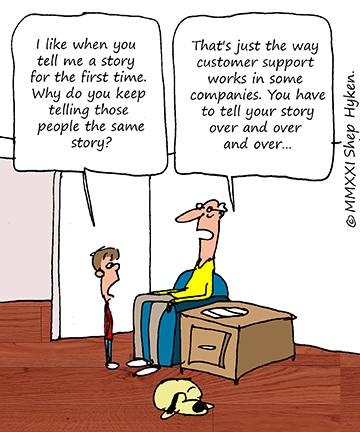 I’m always frustrated when I call a customer support number that I’ve called before and have to retell my story. The same goes for when I’m transferred to another person. There is no need for this.
I’m always frustrated when I call a customer support number that I’ve called before and have to retell my story. The same goes for when I’m transferred to another person. There is no need for this.
I recently posted that message to social media. My friend and fellow customer service and experience expert Jason Bradshaw responded that the same thing happens with online chat. Specifically, he wrote, “This is also why I have never advocated for online chat – I’ve yet to find a company that uses online chat and doesn’t have the customer repeat their story numerous times. The customer wants success, not pain.”
I agree with most of that. Yes, the customer wants success and not pain. However, the chat solution is a great technology for companies to use to support the basics. And a good system will make it easy for a company employee to see the online conversation and continue it, versus start over. As Jason pointed out, that’s not always the case. But when it is, it’s nice.
In the customer service and support world, there are many ways that companies measure success. There’s average handle time (how long it takes to take care of the customer), average hold time, one-call resolution, and more. I’d like to add one more to the many metrics, which is how many times you make the customer tell the story. The goal is simple. Just one time.
One time doesn’t always mean the customer won’t be transferred to someone else, however, when they are transferred, the next person should know why the customer is calling. It could be because the employee explained the issue to another employee. It could simply be in the record. So much can be accomplished with good notetaking. Then, rather than making the customer repeat the story, the employee can use the notes to ask more questions.
Asking questions is far different than having customers repeat themselves, often more than once. What you don’t want to say to the customer is, “I’m sorry, but you’ll have to start at the beginning.”
You may be sorry, but to the customer, those words don’t resolve the issue. By the way, I’m a big fan of saying, “I’m sorry,” but saying it doesn’t solve the problem. Customers don’t typically notice if they only have to tell their story once. It becomes more obvious when they have to repeat their story, sometimes numerous times, and hear, I’m sorry,” over and over.
So, I’ll close with a metaphor to accentuate the point. In the 1970s classic romantic movie Love Story, starring Ali MacGraw and Ryan O’Neal, the famous line was, “Love means never having to say you’re sorry.” In the customer service world, “Love means never having to repeat your story!”
Shep Hyken is a customer service expert, keynote speaker, and New York Times, bestselling business author. For information on The Customer Focus customer service training programs, go to www.thecustomerfocus.com. Follow on Twitter: @Hyken
customer service training programs, go to www.thecustomerfocus.com. Follow on Twitter: @Hyken
(Copyright © MMXXI, Shep Hyken)
The post Don’t Make Me Repeat My Story! appeared first on Shep Hyken.



